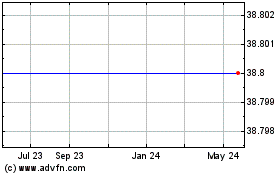UPDATE: Obama Administration Blasts BP For Not Keeping Public Informed
May 20 2010 - 4:59PM
Dow Jones News
The Obama administration on Thursday said BP PLC (BP) isn't
doing enough to keep the government and the public informed about
the Gulf oil spill that continues to gush out of a broken
underwater pipe. Environmental Protection Agency Administrator Lisa
Jackson and Homeland Security Secretary Janet Napolitano said in a
letter to the company's chief executive that while BP has said it
is making every effort to keep the government and public informed,
"Those efforts, to date, have fallen short in both their scope and
effectiveness." The letter comes as the EPA ordered the company to
use a less-toxic chemical dispersant to break up crude oil. The
government and BP have faced intense questioning in recent days
about the size of the oil spill amid evidence that the crude oil
has been caught in currents that may bring it up the east coast of
the U.S.
"We are asking for them to provide the data, put it on the
website, update that website daily," said White House Press
Secretary Robert Gibbs at a daily White House briefing with
reporters. He added, "We think that is what the company owes,
again, both us and the American people as we work through our
response and as the public has questions about their
operations."
The government has said it has been asking for a video that
shows more details about oil spewing out of the sea floor and
water-quality data. Gibbs said he thinks "that they're not going to
want to hide that data."
Gibbs said the EPA has continued to do air and water testing,
though the government doesn't have the technological resources that
BP and other oil companies possess, particularly as it relates to a
well that is 5,000 feet below sea level.
BP has been using a dispersant called Corexit, made by Nalco
Holding Co. (NLC). The EPA authorized BP to use Corexit last week,
but Jackson had said that she was pushing the company to consider
other dispersants that might be less harmful.
Under the directive, BP has 24 hours to identify a "less toxic"
alternative--to be used both at the surface and underwater. The
company must begin using the alternative within 72 hours of
submitting the new chemical for review. If BP can't identify an
alternative, it must provide a detailed description of which
chemicals were considered and why they didn't meet the required
standards.
Dispersants are traditionally used to break up oil slicks on the
sea surface. The risks of their underwater usage over long periods
of time are unknown. Initial testing of Corexit on small fish,
conducted earlier this week, produced survival rates of 80% to 90%,
the EPA chief told reporters Wednesday, but those tests don't
measure long-term effects.
-By Jared A. Favole, Dow Jones Newswires; 202-862-9256;
jared.favole@dowjones.com
-By Siobhan Hughes, Dow Jones Newswires; 202-862-6654;
siobhan.hughes@dowjones.com
Nalco (NYSE:NLC)
Historical Stock Chart
From Aug 2024 to Sep 2024

Nalco (NYSE:NLC)
Historical Stock Chart
From Sep 2023 to Sep 2024
